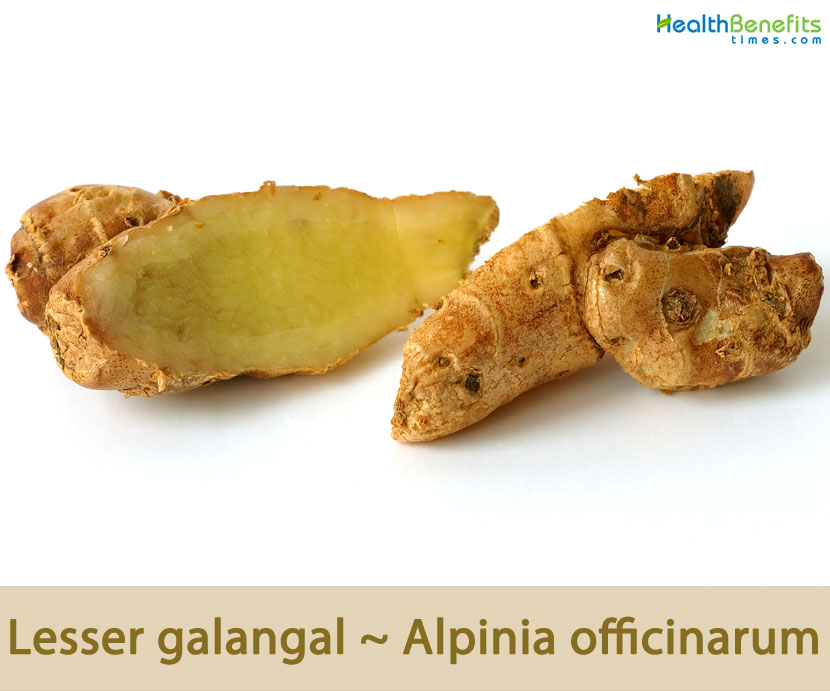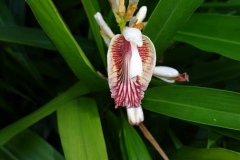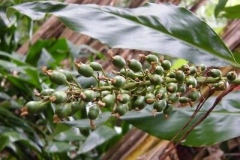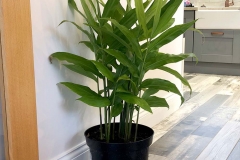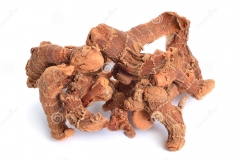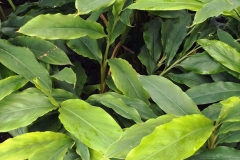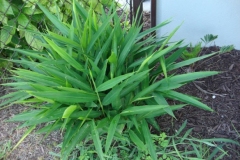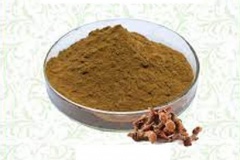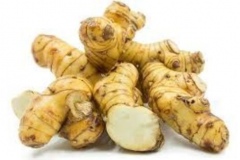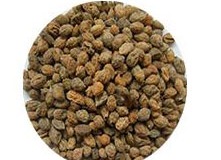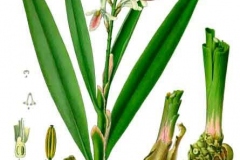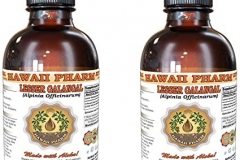| Lesser galangal Quick Facts | |
|---|---|
| Name: | Lesser galangal |
| Scientific Name: | Alpinia officinarum |
| Origin | China, mainly on the southeastern coast, including Hainan, Gg and Guangxi, and is uangdonalso grown in Japan, Thailand, and Vietnam. |
| Colors | Initially green and then turn yellow before finally maturing to red |
| Shapes | Small, round capsule 1 cm in diameter |
| Taste | Acrid |
| Health benefits | Support abdominal pain, emesis, diarrhea, impaired renal function, dysentery, dyspepsia, flatulence, vomiting, gastralgia, colic, fever and malaria |
| Name | Lesser galangal |
|---|---|
| Scientific Name | Alpinia officinarum |
| Native | China, growing mainly on the southeastern coast, including Hainan, Guangdong and Guangxi, and is also grown in Japan, Thailand, and Vietnam. It is also cultivated in the plains of West Bengal, Assam and Eastern Himalayas in Indi. Hong Kong is the commercial center for the sale and distribution of the lesser galangal |
| Common Names | Chinese Ginger, China Root, Colic Root, East India Catarrh Root, Galangal, India Root, Lesser Galanga, Lesser Galangal, Blue ginger, Chewing John, Galangal root, Greater galangal, Kulanjan, Laos, Little John chew |
| Name in Other Languages | Arabic : Kulanjan, khulinjan saghir (خولنجان صغير) Azerbaijani: Dərman alpiniyası Bengali: Punnagchampa Burmese: P tell kaw layy (ပတဲကောလေး) Chinese : Gao Liang Jiang (高良薑) Czech : Galgán Lékařský Danish : Lille Galangal , Galanga, Lille Galangarod Dutch : Galgant, Kalanswortel Estonian: Väike Kalganirohi English: Chinese-ginger, Lesser galanga, Lesser galangal, Galangal, small galangal Finnish: Pikkukalangajuuri French : Galanga Du Chine, Galangal Officinal, Petite galanga Petite Galanga German : Galgant, Echter Galgant, Galgantwurzel, Kleiner Galgant, Siam-Ingwer Hebrew: גלנגל Hindi: Kúlinján Hungarian: Galangál, Kínai Gyömbér Italian: Galanga, Galanga minore Japanese: Kouryoukyou (コウリョウキョウ) Korean: Gal Len Gal (갈렌갈), golyang-gang (고량강) Kurdish: Xavlêcan Lithuanian: Vaistinė alpinija Norwegian : Galangarot, Kinarot Persian : Khusro-Daru, خولنجان Polish : Galgant Chinski Portuguese: Alpinia-menor, galanga-menor Russian : Kalgan Lekarstvennyi (Калган лекарственный), Al’piniia lekarstvennaia Sanskrit: Malayavaca, kulanjana bheda Slovak: Alpínia liečivá Spanish : Galanga, Galangal Swedish : Galangarot, Liten galangarot Tamil: Cirrarattai, Chitharathai, Cittarattai (சிற்றரத்தை) Thailand: Kha Ling (ข่าลิง), Kha Lek (ข่าเล็ก), K̄h̀ā n̂xy (ข่าน้อย) Turkish: Havlıcan Vietnam : Rieng, Rieng Thuoc, Cao Luong Khuong, Co Kha, Kim Sung |
| Plant Growth Habit | Herbaceous, perennial rhizomatous plant |
| Growing Climates | Grasslands and thickets, warm and humid climate |
| Soil | Prefers shady locations and moist, fertile soil rich in organic matter but will grow in full sun |
| Plant Size | Grow 1.5 to 2 m high |
| Rhizome | Woody, branched, dark brown to almost black, cylindrical with distinct nodes and internodes. Nodes are provided with light brown sings, whereas the internodes are finely ridged |
| Leaf | Sessile; ligule lanceolate, entire, 2–3(–5) cm, membranous; leaf blade linear, 20–30 × 1.2–2.5 cm, glabrous, base attenuate, apex caudate |
| Flowering season | April – September |
| Flower | Flowers are numerous; rachis is tomentose; bracteoles are very small, less than 1 cm. Its calyx is tubular and puberulent, and the apex is 3-toothed. Corolla tube is slightly shorter than calyx; lobes are oblong, with the central one hood-like |
| Fruit Shape & Size | small, round capsule 1 cm in diameter |
| Fruit Color | Initially green and then turn yellow before finally maturing to red |
| Flavor/Aroma | Aromatic odor |
| Taste | Acrid |
| Plant Parts Used | Dried rhizome, leaves, flowers, roots |
| Propagation | By division of rhizomes and seeds |
| Available Forms | Fresh, dried, and powdered form |
| Season | May–Nov |
| Other Facts |
|
Plant Description
Lesser galangal is an herbaceous, perennial rhizomatous plant that normally grows about 1.5 to 2 m high from an underground, copiously branched, creeping rhizome. The plant is found growing in grasslands, thickets, warm and humid climate. The plant prefers shady locations and moist, fertile soil rich in organic matter but will also grow in full sun. Rhizomes are 8 – 12 mm in diameter, woody, branched, dark brown to almost black, cylindrical with distinct nodes and internodes. Nodes are provided with light brown sings, whereas the internodes are finely ridged.
Its rhizomes are marked at short intervals by narrow, whitish, somewhat raised rings, which are the scars left by former leaves and are covered with brownish red scales. The inner section shows a dark center surrounded by a wider, paler layer which becomes darker in drying. Its odor is aromatic, and their taste pungent and spicy. Pseudo stems are 40–110 cm high. The rhizomes are valued for their sweet spicy flavor and aromatic scent. These are used throughout Asia in curries and perfumes, and were previously used widely in Europe. They are also used as an herbal remedy.
Leaves
Dark green leaves are sessile; ligule is lanceolate, entire and membranous. Lamina is linear–lanceolate, 25 to 30 cm (10 to 12 in) long and 2 cm (0.8 in) wide, glabrous, base attenuate and apex caudate.
Flowers
Inflorescences of its terminal are erect; dense racemes are 10–20 cm long. Flowers are numerous; rachis is tomentose; bracteoles are very small, less than 1 cm. Its calyx is tubular and puberulent, and the apex is 3-toothed. Corolla tube is slightly shorter than calyx; lobes are oblong, with the central one hood-like. Its labellum is 2 cm long, white with red streaks and ovate. Ovary is tomentose and is 3-celled. Flowering normally takes place in between April and September.
Fruits
Fertile flowers are followed by small, round capsule 1 cm in diameter. Fruits are initially green and then turn yellow before finally maturing to red.
Traditional uses and benefits of Lesser Galangal
- Alpinia officinarum has been used both in Ayurvedic and Chinese medicine since very early times (circa AD 500 in China) and in Europe since the middle Ages.
- Rhizome is reported to be a very effective herb that acts mainly on the digestive system, also relieves pain, lowers fevers and controls bacterial and fungal infections.
- It is given to young children to make them talk early.
- It is especially useful in flatulence, dyspepsia, vomiting and sickness at stomach, being recommended as a remedy for sea sickness.
- It tones up the tissues and is occasionally recommended in fever.
- Homoeopaths use it as a stimulant.
- The powder is used as a snuff for catarrh.
- Dry root stock of A. officinarum Hance is collected in late summer and is used for the treatment of dyspepsia, gastralgia and emesis.
- Traditional Chinese medicine has used the herb as an aromatic stomachic, analgesic and antiemetic in Asia.
- The rhizome of Alpinia officinarum has been used in China for relieving stomach ache, treating colds, invigorating the circulatory system and reducing swelling.
- Dry root and rhizome of Alpinia officinarum has long been used in traditional Chinese medicine for its anti-oxidation, anti-diabetic, antiulcer, anti-diarrhea, antiemetic, analgesia, anti-inflammatory and anticoagulation effects.
- Alpinia officinarum has been used in traditional medicine for the treatment of several conditions, such as abdominal pain, emesis, diarrhea, impaired renal function and dysentery.
- Juice from the boiled rhizome is used to stimulate digestion and treat stomach ache and malaria in Vietnam.
- Crushed rhizome in wine or vinegar is used topically for ringworm skin infections.
- It is included in several compound preparations, but is not now often used alone.
- Rhizomes are widely used in Vietnam for treating stomach problems including dyspepsia, flatulence, vomiting, gastralgia, colic, diarrhea, fever and malaria, and are locally applied to infected gums.
- In Thailand, they are used as a carminative and for indigestion.
- Seeds are used in China, for treating heartburn, cholera, toothache, ague and colds.
- In traditional Chinese medicine lesser galangal is a warming herb used for abdominal pain, vomiting, hiccups, and diarrhea.
- In India it is also used for arthritis and intermittent fevers.
- An infusion of lesser galangal can be used to alleviate painful canker sores and sore gums.
- It is often recommended as a treatment for seasickness.
Culinary Uses
- Alpinia officinarum rhizome is pungent, is aromatic and is used as spice for flavoring food throughout Asian countries.
- Rhizome has been used in Europe as a spice for over 1000 years, but it has now largely gone out of use except in Russia and India.
- Closely resembling ginger, it is used in Russia for flavoring vinegar and the liqueur ‘nastoika’; it is a favorite spice and medicine in Lithuania and Estonia and the Tartars prepare a kind of tea that contains it, and it is used by brewers.
- In Asia the rhizomes are ground to powder for use in curries, drinks, and jellies.
- In India an extract is used in perfumes, and Tatars prepare a tea with it.
- Rhizome can be thinly sliced and added to stir-fries, boiled into curries, cooked into satay, mixed in applesauce, lightly tossed into salads, or used to flavor soups such as tom kha gai, a Thai coconut soup, or samlor kor ko, which is a Cambodian vegetable soup.
- It can also be used in stews, rice, and noodle dishes.
References:
https://www.itis.gov/servlet/SingleRpt/SingleRpt?search_topic=TSN&search_value=506514#null
https://www.missouribotanicalgarden.org/PlantFinder/PlantFinderDetails.aspx?taxonid=287591
https://www.botanical.com/botanical/mgmh/g/galang01.html
http://germoplasma.iniaf.gob.bo/gringlobal/taxonomydetail.aspx?id=101035
https://gd.eppo.int/taxon/AIIOF
http://www.theplantlist.org/tpl/record/kew-218941
http://tropical.theferns.info/viewtropical.php?id=Alpinia+officinarum
https://en.wikipedia.org/wiki/Alpinia_officinarum
https://plants.usda.gov/home/plantProfile?symbol=ALOF4


